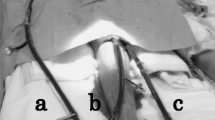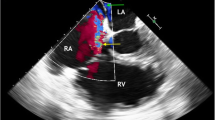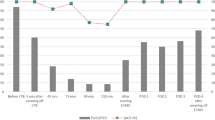Abstract
Differential hypoxia may occur after the initiation of femorofemoral veno-arterial extracorporeal membrane oxygenation (VA ECMO) if cardiac function improves while severe respiratory failure is still present, one of the most difficult problems encountered during VA ECMO. Reconfiguration to veno-arterio-venous ECMO (V-AV ECMO) is one of several methods of dealing with differential hypoxia. V-AV ECMO requires triple cannulation and careful management of the reinjection flow, but the risk of bleeding is lower than in a surgical procedure, such as central ECMO or a subclavian artery graft. Herein, we reported a patient with a massive pulmonary embolism who received VA ECMO, which was reconfigured to V-AV ECMO 3 days later when differential hypoxia occurred. A drainage cannula was newly inserted via the right internal jugular vein, and an existing drainage cannula was used for reinjection after repositioning it caudally. V-AV ECMO is an effective and feasible treatment for differential hypoxia despite the paucity of the procedure to date.




Similar content being viewed by others
References
Falk L, Sallisalmi M, Andersson Lindholm A, et al. Differential hypoxia during venoarterial extracorporeal membrane oxygenation. Perfusion. 2019;34:22–9.
Balciuniene G, Balciunas L, Jakubauskiene L, et al. Massive postpartum pulmonary embolism successfully treated with v-a-v ECMO: a case report. J Obstet Gynaecol. 2020;41:662–4.
Blandino Ortiz A, Belliato M, Broman LM, et al. Early findings after implementation of veno-arteriovenous ECMO: A multicenter European experience. Membranes (Basel). 2021. https://doi.org/10.3390/membranes11020081.
Napp LC, Kuhn C, Hoeper MM, et al. Cannulation strategies for percutaneous extracorporeal membrane oxygenation in adults. Clin Res Cardiol. 2016;105:283–96.
Schmidt M, Tachon G, Devilliers C, et al. Blood oxygenation and decarboxylation determinants during venovenous ECMO for respiratory failure in adults. Intensive Care Med. 2013;39:838–46.
Acknowledgements
Not applicable.
Author information
Authors and Affiliations
Contributions
All the authors contributed to this case report. The first draft of the manuscript was written by TM, and all the authors commented on previous versions of the manuscript. All the authors have read and approved the final version of the manuscript.
Corresponding authors
Ethics declarations
Conflicts of interest
The authors declare that they have no conflicts of interest.
Consent for publication
The patient and his family consented to the publication of the details of the case.
Additional information
Publisher's Note
Springer Nature remains neutral with regard to jurisdictional claims in published maps and institutional affiliations.
Rights and permissions
About this article
Cite this article
Matsuyoshi, T., Shimizu, K., Kaneko, H. et al. Reconfiguration from veno-arterial to veno-arterio-venous extracorporeal membrane oxygenation for massive pulmonary embolism. J Artif Organs 25, 368–372 (2022). https://doi.org/10.1007/s10047-022-01327-2
Received:
Accepted:
Published:
Issue Date:
DOI: https://doi.org/10.1007/s10047-022-01327-2




